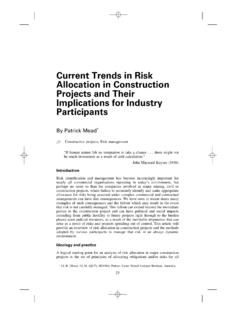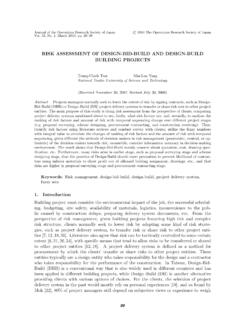Transcription of Risk Transfer and Allocation in PFI/PPP Projects
1 1 KEY POINTSKey Points A National Audit Office (NAO) report shows that transferring much of the risk to the private sector under PFI has led to a marked decrease in project cost and time overruns Public sector risk Transfer has tended towards optimum rather than maximum risk Transfer , and towards investment grade Projects In risk Transfer it is necessary to have a uniform understanding of the definition, scope and reach of the risks Beware of trying to be too precise at the business case stage In quantifying financial risk, distinguish probable loss and maximum potential loss and beware of double counting Identify and quantify the effect of optimism/pessimism bias Performance and availability incentive payments minimise the risk of budget and time overruns Remember trust and relationships count a great deal when discussing risk transferSummaryRisk Transfer and Allocation in PFI/PPP ProjectsSeminar 119 held at Freshfields Bruckhaus Deringer, London 24th May 20052 IntroductionAll Projects are subject to risk.
2 At the planning and consultation stage, the contract stage, the implementation stage and even during maintenance of the finished product. It is important to understand how risk Transfer and Allocation works with Private Finance Initiatives (PFI) and Public Private Partnerships (PPP), both in the UK and internationally. Risk determines whether a project is value for money (vfm): the risk adjusted whole-of-life cost of a project determines whether it should have public or private finance or indeed whether it should proceed at all. From a financial point of view, risk must be measured in terms of cost or lost value.
3 However, the evaluation of risk is often difficult, both in terms of the kind of risk and the detailed information required to make a judgement. At the seminar experienced managers and advisers explained how they tackled risk by looking at examples of particular Projects and particular areas of risk. The discussion identified improved policies and practices for handling risk on PFI/PPP Projects in all meaning of risk Deciding whether or how a project can go ahead depends on its cost, which ultimately depends on events that may take place during the life of the project and even beyond, as inherited liabilities.
4 The concept of risk entails uncertainty: there are uncertainties with known consequences and there are uncertainties of which the consequences cannot be fully determined. Hence the distinction between known unknowns and unknown unknowns. Known unknowns are probable and it is only the range of impact that has to be considered. Of these, inch wide, mile deep risk is where there may be a small probability of things going wrong, but if they do the loss is large. Inch wide, mile deep risk and unknown unknowns can be avoided by careful planning. Particular risk to a project may be in terms of extended process or loss of intrinsic value, but may also be in the form of optimum bias , corporate risk or project agreement risk.
5 When contracts are drawn up, different kinds of risk may be specified along with where liability for cost may measurement of risk The risk-adjusted whole-of-life cost of a project determines whether it should proceed and if it should have public or private finance, or both. Different financial structures enable value-for-money comparisons and these in turn will depend on risk analysis. The steps in risk analysis can be set out in a linear and the risk meta processRisk register Risk Allocation Risk data gathering Risk quantification workshops Risk modelling First, risks are identified and a risk register created so that each risk can be allocated to the public or private sector.
6 The process is, however, fraught with difficulty. It may be complicated by having mixed private and public sector contracts and risk data may depend on professional judgements. The process seems progressive, but the financial model that emerges often has to be modified by going through the whole sequence several times. Moreover, it is as well to be suspicious of any precise numerical answer that might emerge. It is better to identify a number of key issues that need to be addressed as the project proceeds, and formulate a range of answers. Most financial advisers can convert time delays and, usually, quality considerations into monetary terms.
7 However, where contingency allowances are added to core pricing and the whole cost then calculated there is a risk of double counting if allowances for risk are made in different ways. The current UK approach is now to move away from quantitative analysis towards professional judgements in a multidisciplinary environment. People should not try to be too precise at the business case stage. Decisions on whether a project goes ahead should be based on the knowledge that the cost is likely to be between X and Y rather than guess that it is going to cost X. Detailed work is always useful, but any conclusions drawn should be viewed tend to assess risk using a distinction between probable loss and the maximum potential loss, with the aim of achieving low maximum potential loss combined with low probability.
8 Lawyers consider risk in terms of precedence, within the underlying legal framework of the country in which the project is going to be transferPromoters of PPP Projects must find a process which delivers the most cost-effective solution. The National Audit Office (NAO) has also shown that transferring much of the risk to the private sector under PFI, as opposed to traditional procurement, has led to a marked decrease in the number of Projects being late and over budget. Effectiveness of Risk Transfer What has been the history of delivery by PFI and by traditional procurements?
9 The National Audit Office published a report that demonstrated that PFI is delivering on time and to budget better than Projects traditionally procuredTraditionalPFIP rojects over budget73%20% Projects late70%24%Mitigating risk There are, however, some disadvantages for the public sector in risk Transfer to the private sector. The cost of capital is higher and costs are incurred as transaction fees for monoline insurers, financial advisers and lawyers. There may also be social issues if trade unions see potential job losses in PFI. Banks are the traditional financiers, but the financing of large Projects in the UK is usually via bond issue.
10 Monolines are financial advisers who solely handle the financing of Projects and upgrade the guarantees to the bond investors. Bonds are graded according to the strength of the guarantee, and a monoline will, for example, upgrade a triple-B rating to a triple-A bond. The extra cost to the project is then the sum of the premium and the bond investor return. A monoline seeks to provide a guarantee on a zero-loss basis which effectively means that risk has been passed on to various sub-contractors so that the potential loss to the promoters is biasUncertainty leads to what is called optimism bias.







